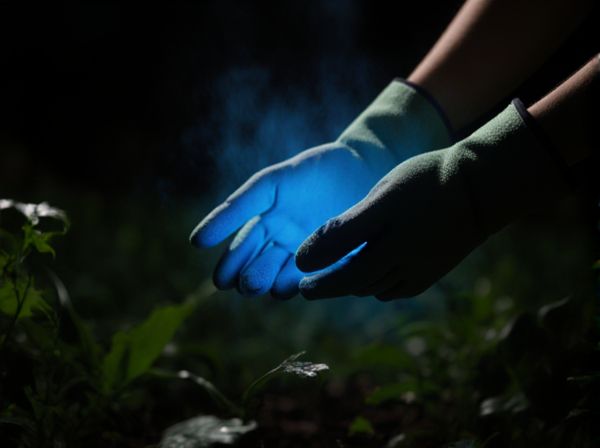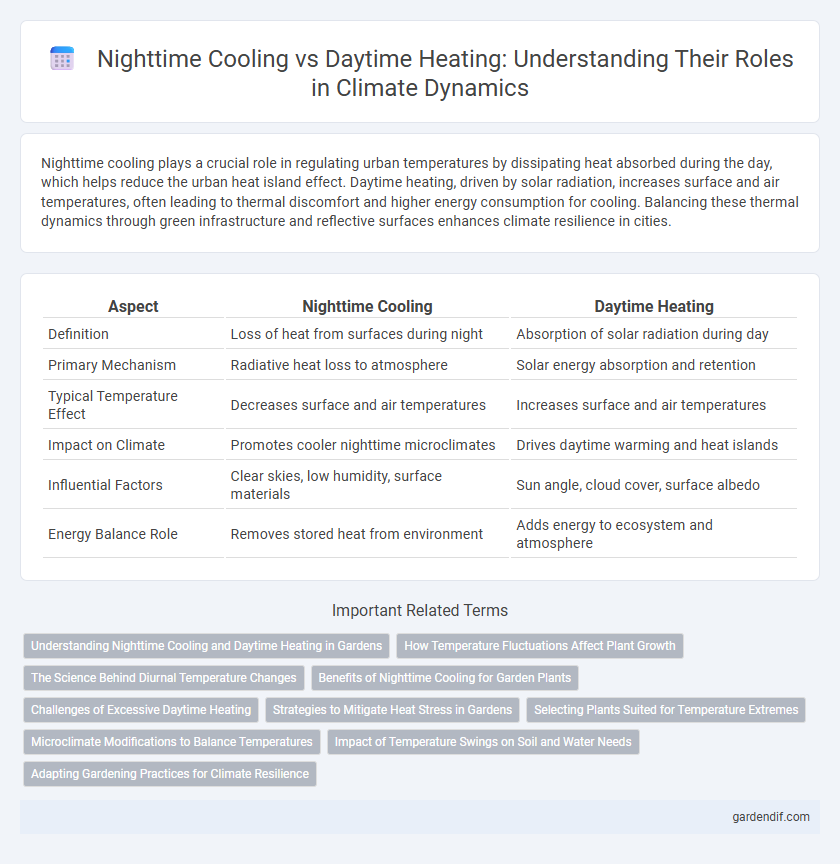
Nighttime cooling vs Daytime heating Illustration
Nighttime cooling plays a crucial role in regulating urban temperatures by dissipating heat absorbed during the day, which helps reduce the urban heat island effect. Daytime heating, driven by solar radiation, increases surface and air temperatures, often leading to thermal discomfort and higher energy consumption for cooling. Balancing these thermal dynamics through green infrastructure and reflective surfaces enhances climate resilience in cities.
Table of Comparison
| Aspect | Nighttime Cooling | Daytime Heating |
|---|---|---|
| Definition | Loss of heat from surfaces during night | Absorption of solar radiation during day |
| Primary Mechanism | Radiative heat loss to atmosphere | Solar energy absorption and retention |
| Typical Temperature Effect | Decreases surface and air temperatures | Increases surface and air temperatures |
| Impact on Climate | Promotes cooler nighttime microclimates | Drives daytime warming and heat islands |
| Influential Factors | Clear skies, low humidity, surface materials | Sun angle, cloud cover, surface albedo |
| Energy Balance Role | Removes stored heat from environment | Adds energy to ecosystem and atmosphere |
Understanding Nighttime Cooling and Daytime Heating in Gardens
Nighttime cooling in gardens reduces soil temperature and moisture evaporation, promoting plant recovery and nutrient absorption. Daytime heating increases photosynthesis and growth rates by providing energy but can also elevate water stress and evaporation. Balancing these temperature fluctuations is critical for optimizing plant health and garden productivity.
How Temperature Fluctuations Affect Plant Growth
Temperature fluctuations between nighttime cooling and daytime heating significantly impact plant growth by influencing metabolic processes such as photosynthesis and respiration. Cooler nighttime temperatures reduce respiration rates, conserving energy, while warmer daytime temperatures enhance photosynthetic activity, promoting biomass accumulation. These diurnal temperature variations also regulate hormone levels and gene expression, ultimately affecting cell expansion and overall plant development.
The Science Behind Diurnal Temperature Changes
Diurnal temperature changes result from the Earth's surface absorbing solar radiation during the day, causing daytime heating, and radiating heat back into the atmosphere at night, leading to nighttime cooling. The differential heating and cooling rates of land, water, and urban surfaces drive these temperature fluctuations, influenced by factors such as cloud cover, humidity, and wind patterns. Understanding these processes is essential for predicting local climate variations and managing urban heat island effects.
Benefits of Nighttime Cooling for Garden Plants
Nighttime cooling reduces plant stress by lowering leaf temperatures, which enhances respiration and promotes nutrient uptake. Cooler nighttime conditions help conserve soil moisture, reducing water loss through evaporation and supporting stronger root development. This temperature regulation also minimizes heat-induced damage, improving overall plant health and increasing resistance to pests and diseases.
Challenges of Excessive Daytime Heating
Excessive daytime heating drastically raises urban temperatures, intensifying heat islands and increasing energy demands for cooling systems, which contributes to higher carbon emissions. This phenomenon exacerbates health risks such as heatstroke and respiratory issues, especially in vulnerable populations lacking adequate shelter or air conditioning. Mitigating these challenges requires implementing green infrastructure, reflective materials, and urban planning strategies to balance thermal loads and enhance nighttime cooling efficiency.
Strategies to Mitigate Heat Stress in Gardens
Implementing nighttime cooling strategies such as increased ventilation and evapotranspiration helps reduce accumulated heat in gardens, promoting plant resilience. Shading techniques combined with reflective mulches minimize daytime heating by lowering soil and ambient temperatures. Selecting drought-resistant plant species and optimizing irrigation timing supports heat stress mitigation by enhancing water retention during peak heat hours.
Selecting Plants Suited for Temperature Extremes
Selecting plants adapted to nighttime cooling and daytime heating is essential for thriving gardens in extreme temperature zones. Succulents, cacti, and heat-tolerant perennials like lavender and agave efficiently withstand daytime heat while maintaining hydration during cooler nights. Incorporating native species with proven resilience to temperature fluctuations enhances plant survival and reduces water consumption in climate-stressed environments.
Microclimate Modifications to Balance Temperatures
Microclimate modifications such as green roofs, reflective surfaces, and strategic vegetation placement enhance nighttime cooling by increasing radiative heat loss and reducing heat absorption during the day. These interventions moderate temperature extremes, stabilizing local climates and improving urban thermal comfort. Optimized design of microclimates minimizes the urban heat island effect by balancing daytime heating and nighttime cooling dynamics.
Impact of Temperature Swings on Soil and Water Needs
Temperature swings between nighttime cooling and daytime heating significantly affect soil moisture levels and plant water requirements, as rapid cooling can reduce evaporation rates while intense daytime heating increases transpiration. These fluctuations disrupt the soil's ability to retain water, causing variable moisture availability that challenges irrigation scheduling and crop hydration. Managing these impacts through adaptive soil management and precise water delivery is critical for optimizing agricultural productivity and conserving water resources under changing climatic conditions.
Adapting Gardening Practices for Climate Resilience
Nighttime cooling and daytime heating significantly impact plant growth and soil moisture, influencing gardening success in changing climates. Adapting gardening practices by selecting heat-tolerant and cold-resilient plant varieties helps mitigate stress from temperature extremes. Implementing mulching and optimizing irrigation schedules further enhances moisture retention and temperature regulation for climate-resilient gardens.
Nighttime cooling vs Daytime heating Infographic

 gardendif.com
gardendif.com